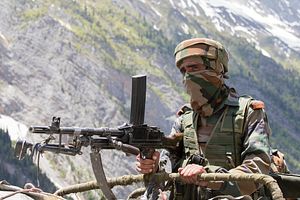While India is trying its best to secure a permanent seat at the United Nations, back in Kashmir its armed forces are introducing new weapons to be used on civilians. In October, a flash grenade was used during protests in the capital city of Srinagar. The grenade burned nine-year-old Aamir’s face and arm. He is another casualty of the continuous and violent repression India has been using against the people of Kashmir for more than two decades now.
The situation in the Valley has been grim ever since the first bomb blasts in 1988; the attacks marked the beginning of an armed rebellion for the right to self-determination that still continues. During the 1990s, India used torture, coercion, killings, enforced disappearances, kidnappings, and government corruption to maintain its control over Kashmir.
Despite the thousands of human rights violations in the region, few men in uniform involved have faced justice. Rights’ groups have been demanding investigations into these cases by an impartial international body. A local human rights group, the Jammu Kashmir Coalition of Civil Society (JKCCS), run by Parvez Imroz, a lawyer, has documented human rights violations committed by the Indian armed forces. The group has also exposed more than 7,000 mass graves over the years. Despite these revelations, the government has yet to take action.
The latest 800-page report, Structures of Violence, released by the group, examines 333 case studies that span over four chapters. The report names 972 perpetrators of human rights violations: 464 army personnel, 189 government gunmen, 158 Jammu and Kashmir police personnel, and 161 paramilitary personnel.
A striking feature of such reports is the impunity enjoyed by these perpetrators under the law of the land, the Armed Forces (Special Powers) Act (AFSPA). In the majority of the cases, justice has never been delivered despite overwhelming evidence and eyewitness accounts. One such example is the Kunan Poshpora mass rape case of February 23, 1991, in which dozens of women claimed they had been raped by Indian army personnel, while the male family members of the women were tortured.
The survivors of these atrocities have been demanding an independent probe by an international body but the government has paid little heed to these reports. Every month, the families and relatives of the enforced disappearance victims stage a sit-in protest, demanding the whereabouts of their loved ones. Human rights groups claim around 10,000 people have been forcefully disappeared by Indian authorities.
Coming to the present, the number of human rights violations has come down, but the past years have been a strong reminder for people that protests against India must continue. In the last few years, since 2008, mostly children have been facing rights violations. When stone-throwing became popular in Kashmir, the authorities used the ways of the 1990s to crush any civilian resistance. In some cases, petrol was injected into the children’s veins to cause pain. Minors were put in jail and psychologically tortured.
The current coalition government in Kashmir, comprising the nationally dominant Bharatiya Janata Party (BJP) and the People’s Democratic Party (PDP), has followed previous governments in ignoring the demands of rights’ groups. Surprisingly, the chief minister, Mufti Sayeed, recently praised the Indian army for its role in “securing borders and safeguarding the lives of the people.”
In 2014, the army did sentence five of its personnel to life imprisonment for staging an encounter involving three civilians in the Machil area of Kupwara district in 2010. The trio were branded as foreign militants and killed for rewards and remunerations. The killings ignited the 2010 mass protests, which resulted in the killing of more than 120 civilians by the police and paramilitary forces. Despite the charged atmosphere in the region, the army and other forces continue to kill civilians, further escalating the situation for the worse.
The government’s ignorance of reports on the pitiful state of human rights in Kashmir has resulted in a general sense of hopelessness and a lack of trust in the state and law enforcers. While efforts are being made to return peace to the troubled region, human rights violations prevent any semblance of normalcy from returning to Kashmir. The region may look peaceful from the outside or while sitting in the tourist-friendly spots of the Valley, but back in the homes of survivors, peace is a distant dream.
The scars on nine-year-old Aamir’s face, visible as he lies on a hospital bed, are the reason that peace will never return to Kashmir. Until the grievances of the protesters are heard, change cannot take place. A flash grenade, bullet, or a tear gas shell can silence an individual, but there are hundreds of thousands affected by the impunity and lack of accountability with which Indian forces operate in the politically disputed region of Kashmir. Silencing them and ignoring the core issue of their right to self-determination will forever keep peace at a distance.
Fahad Shah is a journalist and writer. He is the editor of the anthology Of Occupation and Resistance: Writings from Kashmir (Westland, 2013) and also the editor of The Kashmir Walla magazine. He tweets at @pzfahad.

































